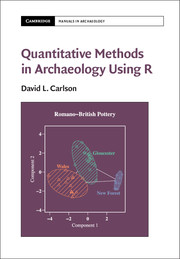Book contents
- Frontmatter
- Contents
- List of Figures
- List of Tables
- List of Boxes
- Acknowledgments
- 1 Introduction
- PART I R AND BASIC STATISTICS
- PART II MULTIVARIATE METHODS
- 10 Multiple Regression and Generalized Linear Models
- 11 MANOVA and Discriminant Analysis
- 12 Principal Components Analysis
- 13 Correspondence Analysis
- 14 Distances and Scaling
- 15 Cluster Analysis
- PART III ARCHAEOLOGICAL APPROACHES TO DATA
- References
- Index
11 - MANOVA and Discriminant Analysis
from PART II - MULTIVARIATE METHODS
Published online by Cambridge University Press: 22 July 2017
- Frontmatter
- Contents
- List of Figures
- List of Tables
- List of Boxes
- Acknowledgments
- 1 Introduction
- PART I R AND BASIC STATISTICS
- PART II MULTIVARIATE METHODS
- 10 Multiple Regression and Generalized Linear Models
- 11 MANOVA and Discriminant Analysis
- 12 Principal Components Analysis
- 13 Correspondence Analysis
- 14 Distances and Scaling
- 15 Cluster Analysis
- PART III ARCHAEOLOGICAL APPROACHES TO DATA
- References
- Index
Summary
In Chapter 10, we expanded on linear regression by using more than one explanatory variable on the right-hand side of the formula. In this chapter, we will expand on t-tests and analysis of variance from Chapter 8 by adding more than one response variable on the left-hand side of the formula. Hotelling's T test is a multivariate expansion of the t-test and multivariate analysis of variance (MANOVA) is a multivariate expansion of analysis of variance. In many cases, we have multiple measures of artifact shape or composition and running t-tests separately on each variable creates multiple comparisons problems. Also the tests are not really independent if the variables are correlated with one another as they often are. Hotelling's T and MANOVA provide an overall test of the difference between the groups based on all of the numeric variables. The tests of significance are on these linear combinations rather than the original separate variables.
Discriminant analysis involves a similar process in that we are looking for linear combinations of variables that allow us to predict a categorical variable. The most common archaeological application is in compositional analysis where we are trying to characterize different sources (geological sources or manufacturing sources) on the basis of molecular or elemental composition. Discriminant analysis includes two separate but related analyses. One is the description of differences between groups (descriptive discriminant analysis) and the second involves predicting to what group an observation belongs (predictive discriminant analysis, Huberty and Olejink 2006).
Descriptive discriminant analysis is based on multivariate analysis of variance. Instead of a single numeric dependent (response) variable, we have several variables. To test for differences between groups, we compute linear combinations of the original variables and then test for significant differences between the linear combinations. A linear combination is like a multiple regression equation in the sense that each variable is multiplied by a value and summed to produce a new value that summarizes variability in the original variables. Descriptive discriminant analysis is also described as canonical discriminant analysis and the linear components are referred to as canonical variates. The method is used to visualize the similarities and differences between groups in two or three dimensions.
- Type
- Chapter
- Information
- Quantitative Methods in Archaeology Using R , pp. 244 - 264Publisher: Cambridge University PressPrint publication year: 2017



